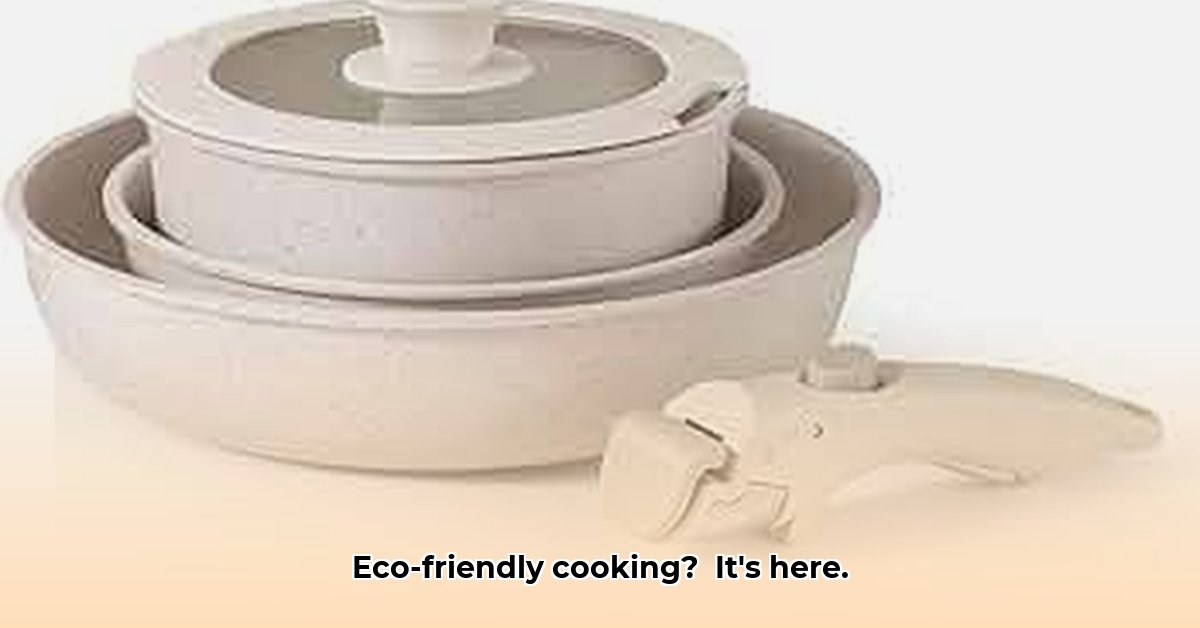Got a tiny kitchen and a big heart for the planet? Removable handle cookware might be your new best friend. These clever sets save space and can be surprisingly eco-friendly. This article digs into the world of sustainable detachable cookware, helping you navigate the green options and choose the best fit for your kitchen and conscience. We’ll cover everything from the materials used to how to spot truly sustainable brands, so you can cook up delicious meals without weighing down the Earth. For more on sustainable home goods, check out [this resource](https://www.wavesold.com/rag-and-rug/).
Removable Handle Cookware: Your Eco-Friendly Kitchen Upgrade
Removable handle cookware: it’s not just a space-saving kitchen marvel; it’s a growing trend that’s making waves in the world of sustainable living. Imagine easily storing those bulky pots and pans, freeing up valuable cabinet space. Now, imagine that same convenience combined with an eco-conscious approach to cooking. That’s the promise of green removable handle cookware. But with so many options flooding the market, how do you navigate the choices and ensure you’re actually making a difference? Let’s dive in.
The Sustainability Landscape: Decoding the Green Claims and Eco-Friendly Certifications
Choosing sustainable cookware is more than just picking a pretty pan; it’s about making informed decisions that minimize your environmental footprint. The challenge? Lots of companies boast about being “eco-friendly,” but the reality is often murkier. How can you tell the difference between genuine commitment and clever marketing?
Certifications are a good starting point. Look for labels like the Recycled Claim Standard (RCS) and Global Recycled Standard (GRS). These certifications verify the amount of recycled material used, providing transparency that’s often missing. Another key certification is ClimatePartner, which shows a company’s dedication to reducing its carbon emissions throughout the product’s life cycle, from manufacturing to shipping. Look also for certifications from organizations like B Corp, which indicates a company meets high standards of social and environmental performance, accountability, and transparency.
However, comparing different brands isn’t always easy. Companies sometimes report their sustainability efforts differently, making direct comparisons tricky. One company might highlight the percentage of recycled aluminum, while another focuses on the reduced carbon emissions of its manufacturing process. It’s a bit like comparing apples and oranges, making it tough to pick the “greenest” option. We need standardized reporting across the board for clearer comparisons, including standardized Life Cycle Assessments (LCAs) that evaluate the environmental impact of a product from cradle to grave.
Material Matters: A Closer Look at Cookware Material Impacts and Eco-Friendly Manufacturing
The material your cookware is made from plays a huge role in its environmental impact. Let’s take a look at some common choices:
- Stainless Steel: Stainless steel cookware is known for its durability and resistance to wear and tear. However, its production process requires significant energy, making its carbon footprint relatively high compared to some alternatives. Look for stainless steel made from a high percentage of recycled content, as this can significantly reduce its environmental impact. The grade of stainless steel also matters; 304 stainless steel is generally considered more durable and resistant to corrosion than lower grades.
- Aluminum: Aluminum is lightweight, conducts heat efficiently, and generally requires less energy to produce initially than stainless steel. However, the mining and processing of aluminum can still have environmental consequences, particularly if not sourced responsibly. Recycled aluminum is a much more sustainable option, using significantly less energy than virgin aluminum production. Consider cookware made from recycled aluminum and look for certifications that verify the recycled content.
- Cast Iron: Cast iron is incredibly durable and can last for generations, making it a very sustainable choice in the long run. It also retains heat extremely well, which can save energy during cooking. However, cast iron is heavy and requires seasoning to prevent rusting. Look for cast iron cookware made from recycled materials or produced using sustainable manufacturing processes.
- Ceramic Coatings: Many people love the non-stick convenience of ceramic-coated cookware. However, the longevity of these coatings varies greatly among different brands and models. There are also concerns about potential microplastic shedding, which could contribute to environmental pollution. Always look for cookware that’s explicitly free of PFOA (perfluorooctanoic acid) and PTFE (polytetrafluoroethylene) – these chemicals are linked to both environmental harm and health concerns. Research the specific type of ceramic coating used, as some are more durable and resistant to scratching than others.
- Copper: Copper cookware is prized for its excellent heat conductivity, allowing for precise temperature control. However, copper mining can have significant environmental impacts. Look for copper cookware that is either vintage/reclaimed or sourced from responsible mining operations.
It’s worth noting that ongoing research continues to refine our understanding of the environmental impact of each material. New technologies and manufacturing processes are constantly being developed, potentially altering the sustainability standings of different materials over time. Innovations in bio-based coatings and more sustainable metal extraction methods are promising developments to watch.
Decoding the Labels: Your Shopping Checklist for Sustainable Cookware
Buying sustainable cookware means being a savvy shopper. Here’s a checklist to help you make eco-friendly choices:
- Verify Certifications: Look for RCS, GRS, ClimatePartner and B Corp Certifications. These provide independent verification of a product’s sustainability claims.
- Material Matters: Prioritize cookware made with recycled materials. High percentages of recycled content usually indicate a stronger commitment to sustainability. Also consider the overall durability and lifespan of the material.
- PFOA & PTFE-Free: Always check for these harmful chemicals. They’re frequently found in traditional non-stick coatings but cause significant environmental problems. Look for alternative coatings like ceramic or silicone that are free of these chemicals.
- Durability is Key: A high-quality, durable pan will last longer, reducing the need for frequent replacements and minimizing waste. Think long-term; it’s better to invest in a high-quality, sustainable piece than buy cheap alternatives that end up in the landfill sooner. Consider the warranty offered by the manufacturer, as this can be an indicator of the product’s expected lifespan.
- Transparency is Crucial: Look for brands that are transparent about their manufacturing processes and environmental impact. Check their websites for details on sustainability initiatives and raw material sourcing. Contact the company directly to ask questions about their sustainability practices if the information is not readily available.
- Packaging Considerations: Opt for cookware that comes in minimal and recyclable packaging. Avoid excessive plastic packaging and look for brands that use recycled cardboard or other sustainable materials.
- Check the Country of Origin: While not always indicative of sustainability, knowing where the cookware is manufactured can provide insights into labor practices and environmental regulations. Look for brands that manufacture in countries with strong environmental protections and fair labor standards.
Brand Spotlight: Finding and Supporting Eco-Friendly Cookware Champions
(Note: Because the cookware market is constantly evolving, I can’t provide specific brand endorsements here. It’s always best to do your own research to find the options that best reflect your values and budget.) When researching a brand, consider these factors:
- Company Mission and Values: Does the company have a clear commitment to sustainability and ethical business practices?
- Supply Chain Transparency: Can the company provide information about its raw material sourcing and manufacturing processes?
- Certifications and Awards: Has the company received any third-party certifications or awards for its sustainability efforts?
- Customer Reviews: What are other customers saying about the durability and performance of the cookware?
- End-of-Life Programs: Does the company offer any programs for recycling or responsibly disposing of its cookware at the end of its lifespan?
The Future of Sustainable Cookware & Industry-Wide Standards
The future of eco-friendly cookware hinges on several critical fronts. Innovation in materials is essential. We need to develop more durable, readily recyclable materials with minimal environmental impact throughout their lifecycles. This includes exploring bio-based materials and more sustainable alternatives to traditional non-stick coatings. Stronger industry-wide standards for reporting sustainability metrics are also crucial. Clear, consistent reporting would allow consumers to compare products accurately. Ultimately, the goal is complete transparency, allowing consumers to make truly informed decisions and hold brands accountable for their sustainability claims. The collective responsibility lies on both manufacturers to prioritize sustainable practices and consumers to demand them. Your choices matter. Government regulations and incentives can also play a role in promoting sustainable cookware production and consumption. Tax breaks for companies that use recycled materials and subsidies for consumers who purchase eco-friendly cookware are just a few examples of how policy can drive positive change.
How to Compare Sustainability Certifications for Detachable Handle Cookware
Key Takeaways:
- Consumer demand for sustainable cookware is rising.
- Detachable handle cookware offers space-saving advantages.
- Several certifications exist, but consistent standards are lacking.
- Material choices significantly impact environmental footprint.
- Transparency and clear labeling are crucial for informed purchasing decisions.
Navigating the Green Maze: Understanding Sustainability Certifications for the Eco-Conscious Kitchen
Choosing eco-friendly cookware can feel like deciphering a secret code. So many certifications! How do you know which ones truly mean something? Let’s demystify how to compare sustainability certifications for detachable handle cookware. A helpful approach is to categorize certifications by what they measure:
- Recycled Content: RCS and GRS are key here, ensuring a percentage of the product comes from recycled materials.
- Carbon Footprint: Look for ClimatePartner or similar carbon-neutral certifications, indicating the company is actively working to reduce emissions.
- Overall Sustainability: B Corp certification assesses a company’s
- Backsplash For Gray Cabinets: Choosing the Right Backsplash Style - December 13, 2025
- Gray And White Backsplash: Ideas For Timeless Style - December 12, 2025
- Gray Kitchen Backsplash Ideas: Find Your Perfect Gray Tile - December 11, 2025









